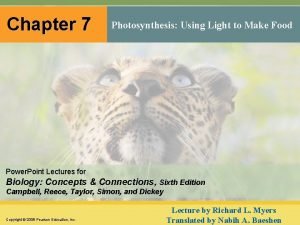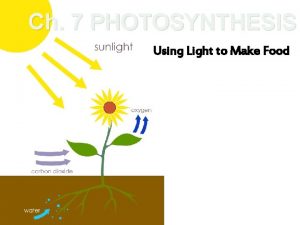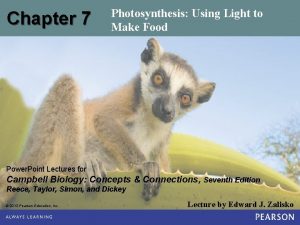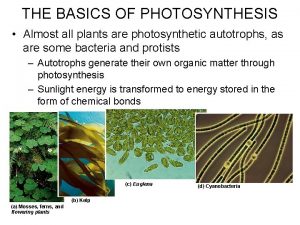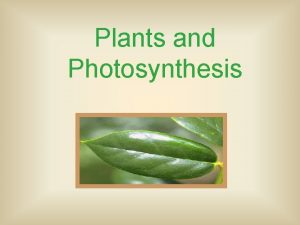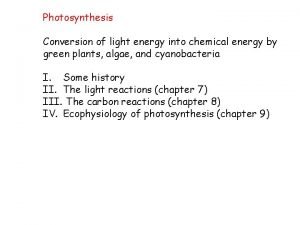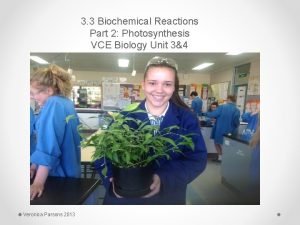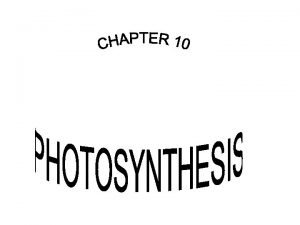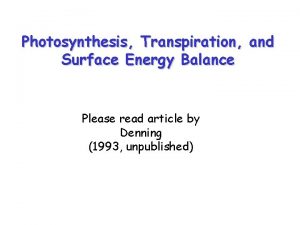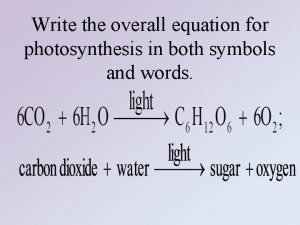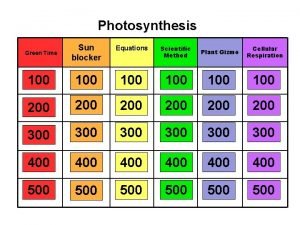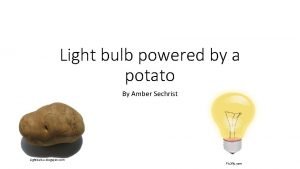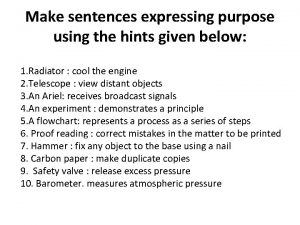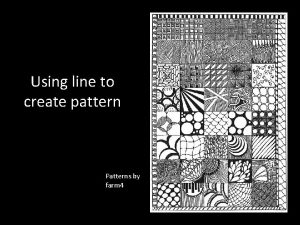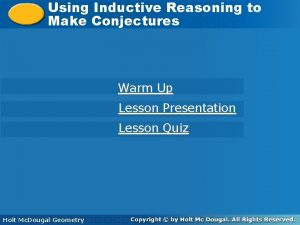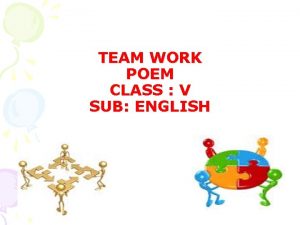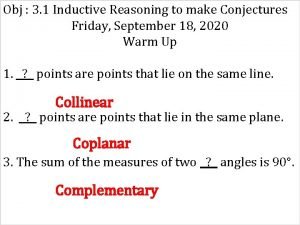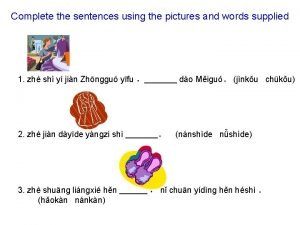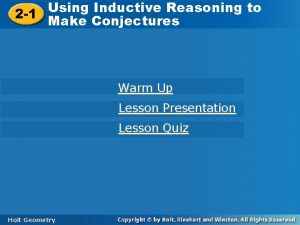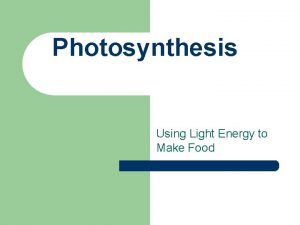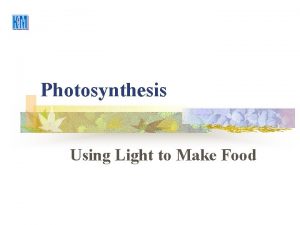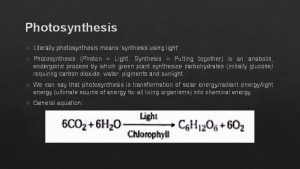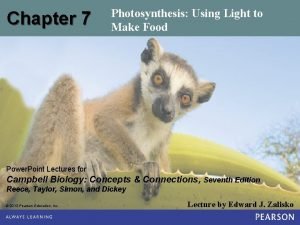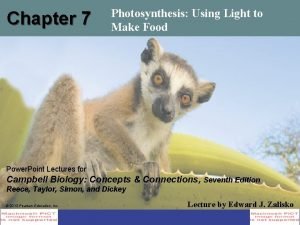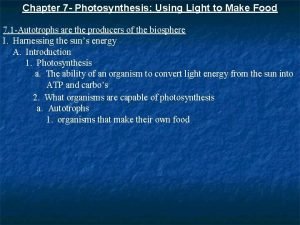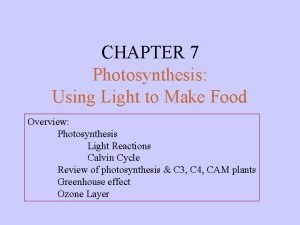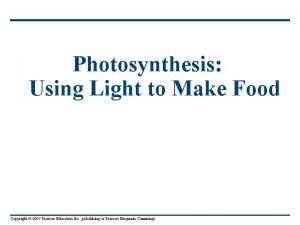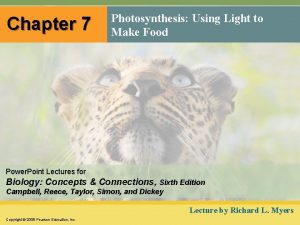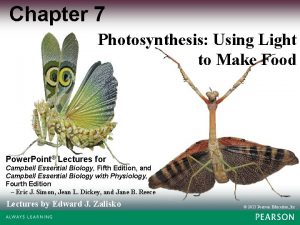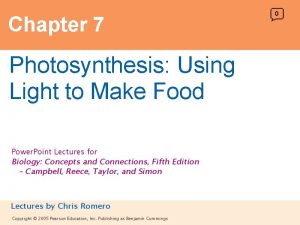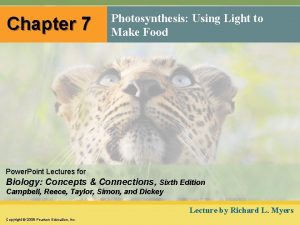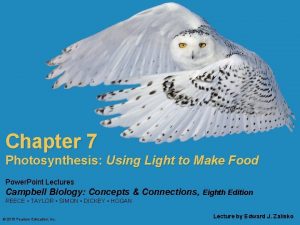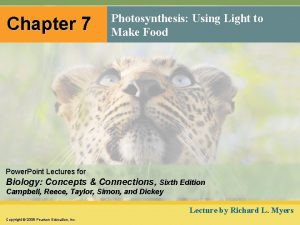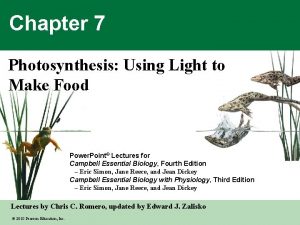Ch 7 PHOTOSYNTHESIS Using Light to Make Food








































- Slides: 40

Ch. 7 PHOTOSYNTHESIS Using Light to Make Food

Autotrophs Are the Producers of The Biosphere § Autotrophs make their own food § Photoautotrophs use the energy of light and chloroplasts to produce organic molecules – Most plants, algae and other protists, some prokaryotes (cyanobacteria) Copyright © 2009 Pearson Education, Inc.


Chloroplast Outer and inner membranes Thylakoid Stroma Granum Thylakoid space Intermembrane space

Visible Radiation Drives the Light Reactions § Sunlight is a type of electromagnetic energy (radiation) § Visible light is a small part of the EM spectrum § Light travels in waves and is particulate – One wavelength = distance between the crests of two adjacent waves (shorter λ’s have more energy) – Photons are discrete packets of light energy (they contain a fixed quantity of light energy)

Increasing energy 10– 5 nm 10– 3 nm Gamma rays X-rays 1 nm 103 nm UV 1 m 106 nm Infrared Microwaves 103 m Radio waves Visible light 380 400 600 500 Wavelength (nm) 700 650 nm 750

Visible Radiation Drives the Light Reactions § Pigments § Are proteins § Absorb specific wavelengths of light, transmit others § The color of a pigment is the color of light most reflected or transmitted by that pigment – Ex. chlorophyll reflects/transmits green and appears green § Various pigments are built into the thylakoid membrane of the chloroplast

Visible Radiation Drives the Light Reactions § Chloroplasts contain several different pigments and all absorb light of different wavelengths – Chlorophyll a: absorbs blue violet and red light and reflects green – Chlorophyll b: absorbs blue and orange and reflects yellow-green – The carotenoids: absorb mainly blue-green light and reflect yellow and orange

§ Photosynthesis is a process that converts solar energy to chemical energy § Plants use water and atmospheric carbon dioxide to produce a simple sugar and release oxygen 6 CO 2 + 6 H 2 O Carbon dioxide Water Light energy Photosynthesis C 6 H 12 O 6 + 6 O 2 Glucose Oxygen gas

Photosynthesis Occurs in Chloroplasts in Plant Cells § Leaves have: § Stomata = pores that allow CO 2 to enter and O 2 to exit § Veins transport water & nutrients absorbed by roots. Vein § Chloroplasts = site of photosynthesis § Contain the green pigment chlorophyll CO 2 Chloroplasts Stoma

Photosynthesis is a Redox Process, as is Cellular Respiration § A loss of electrons = oxidation § A gain of electrons = reduction § Electrons are lost and gained in the form of hydrogen § During redox reactions of photosynthesis, H 2 O donates electrons and is oxidized, CO 2 accepts electrons and is reduced Reduction 6 CO 2 + 6 H 2 O C 6 H 12 O 6 + 6 O 2 Oxidation

CO 2 H 2 O Chloroplast Light NADP+ ADP P LIGHT REACTIONS CALVIN CYCLE (in stroma) (in thylakoids) ATP NADPH O 2 Sugar

The “Photo” in Photosynthesis: THE LIGHT REACTIONS

Photosystems Capture Solar Power in the Light Reactions Photosystem § A photosystem is a functional unit that captures sunlight and helps convert it to the chemical energy of ATP & NADPH § A Photosystem has a light -harvesting complex surrounding a reaction center § chl. a and a primary eacceptor are in the reaction center Light-harvesting complexes Reaction center e– Pigmen molecule Pair of Chlorophyll a molecules

Photosystems Capture Solar Power in the Light Reactions § Two photosystems exist: photosystem I and photosystem II – Each photosystem has a characteristic reaction center – Photosystem II: functions first; the chl. a of this photosystem is called P 680 (it best absorbs light at 680 nm or red) – Photosystem I: functions next; the chl. a of this photosystem is called P 700 (it best absorbs light at 700 nm, also red)

Photosystems Capture Solar Power in the Light Reactions § Light energy is absorbed by pigments of PS II and passed from pigment to pigment NADPH NADP + H Electron transport chain Photon Provides energy within the forphotosystem synthesis of 6 + Photon Photosystem II Stroma 1 Primary acceptor 2 e– Thylakoid membrane e– e– 3 H 2 O 1 2 Photosystem I by chemiosmosis § The energy passes to chl. a, exciting its Primary electrons acceptor e– § An excited e- from chl. a is transferred to 4 5 the primary electron acceptor P 700 P 680 Thylakoid space ATP + + O 2 + 2 H § An enzyme oxidizes water and gives the electrons to chl. a –This step releases oxygen

The Electron Transport Chain – Each photoexcited e- passes from the primary e- acceptor of PS II to PS I via an electron transport chain (ETC) – The exergonic “fall” of electrons down the ETC will help generate a H+ gradient used to generate ATP. – The ETC is a bridge between photosystems II and I

The Electron Transport Chain Photosystem II Stroma NADP+ + H+ Photon 1 Primary acceptor 2 e– Thylakoid membrane e– 4 P 700 P 680 Thylakoid space 3 H 2 O 1 2 5 O 2 + 2 H+ 6 NADPH

The Electron Transport Chain § The ETC accepts electrons from PS II § Electrons are passed along ETC and the 2 nd protein complex pumps H+ into the thylakoid space § This generates a proton (H+) gradient § H+ flows from the thylakoid space to the stroma, down its gradeint, through an ATP synthase. § ATP synthase phosphorylates ADP forming ATP § This is an energy-coupling process called chemiosmosis, where the exergonic flow of H+ powers the endergonic phosphorylation of ADP

Stroma (low H+ concentration) H+ H+ PS II H 2 O 1 2 O 2 + 2 H+ NADP+ + H+ H+ H+ ADP + P NADPH H+ ATP PS I H+ H+ H+ Electron transport chain Thylakoid space (high H+ concentration) H+ H+ H+ ATP synthase

The Light Reactions – Electrons moving down the ETC are passed to chl. a of PS I – NADP+ reductase transfers electrons from PS I to NADP+ forming NADPH

Stroma (low H+ concentration) H+ H+ PS II H 2 O 1 2 O 2 + 2 H+ NADP+ + H+ H+ H+ ADP + P NADPH H+ ATP PS I H+ H+ H+ Electron transport chain Thylakoid space (high H+ concentration) H+ H+ H+ ATP synthase

The Light Reactions § As a result of the light reactions, ATP and NADPH are produced (in the stroma) § Photophosphorylation is the process of generating ATP from ADP & phosphate by means of a proton-motive force generated by the thylakoid membrane in the light reactions of photosynthesis

THE CALVIN CYCLE: CONVERTING CO 2 TO SUGAR

ATP and NADPH Power Sugar Synthesis in the Calvin Cycle § The Calvin cycle makes sugar within a chloroplast § Atmospheric CO 2, ATP, and NADPH are required to produce sugar § Using these three ingredients, a three-carbon sugar called glyceraldehyde-3 -phosphate (G 3 P) is produced § A plant cell may G 3 P to make glucose and other organic molecules CO 2 Input ATP NADPH CALVIN CYCLE Output: G 3 P

ATP and NADPH Power Sugar Synthesis in the Calvin Cycle § The Calvin Cycle Has Three Phases: 1. Carbon Fixation- Atmospheric carbon (CO 2) is incorporated into a molecule of ribulose bisphosphate (Ru. BP) by the enzyme rubisco § 3 molecules of CO 2 are required to make 1 molecule of G 3 P 2. Reduction Phase – NADPH reduces 3 PGA to G 3 P 3. Regeneration of Starting Material – Ru. BP is regenerated and the cycle starts again Copyright © 2009 Pearson Education, Inc.

Step 1 Carbon fixation Input: 3 CO 2 Rubisco 1 P 3 P 6 Ru. BP CALVIN CYCLE P 3 -PGA

Step 1 Carbon fixation Input: 3 CO 2 Rubisco 1 Step 2 Reduction P 3 P P 6 Ru. BP 3 -PGA 6 ATP 6 ADP + P CALVIN 2 CYCLE 6 NADPH 6 NADP+ P 6 G 3 P

Step 1 Carbon fixation Input: 3 CO 2 Rubisco 1 Step 2 Reduction P 3 P P 6 Ru. BP 3 -PGA 6 ATP 6 ADP + P CALVIN 2 CYCLE 6 NADPH 6 NADP+ P 5 P 6 G 3 P Output: 1 P G 3 P Glucose and other compounds

Step 1 Carbon fixation Input: 3 CO 2 Rubisco 1 Step 2 Reduction P 3 P P 6 Ru. BP 3 -PGA 6 3 ADP 3 Step ATP 6 ADP + P ATP CALVIN 3 2 CYCLE 6 NADPH 3 Regeneration of Ru. BP 6 NADP+ P 5 P 6 G 3 P Output: 1 P G 3 P Glucose and other compounds

Overview of Photosynthesis

PHOTOSYNTHESIS REVIEWED AND EXTENDED Copyright © 2009 Pearson Education, Inc.

CO 2 H 2 O Chloroplast Light NADP+ ADP + P Photosystem II Thylakoid membranes Ru. BP CALVIN CYCLE 3 -PGA (in stroma) Electron transport chains Photosystem I ATP NADPH Stroma G 3 P O 2 Sugars LIGHT REACTIONS CALVIN CYCLE Cellular respiration Cellulose Starch Other organic compounds


EVOLUTION CONNECTION: Adaptations that save water in hot, dry climates evolved in C 4 and CAM plants § In hot climates, plant stomata close to reduce water loss so oxygen builds up – Rubisco adds oxygen instead of carbon dioxide to Ru. BP in a process called photorespiration – Photorespiration uses oxygen, produces CO 2; sugar and ATP are not produced Copyright © 2009 Pearson Education, Inc.

EVOLUTION CONNECTION: Adaptations that save water in hot, dry climates evolved in C 4 and CAM plants § C 4 plants § Have a unique leaf anatomy § First stable compound is a 4 C compound § C 4 plants partially shut stomata when hot and dry to conserve water § Have PEP carboxylase to bind CO 2 at low levels (carbon fixation) § Allows plant to maintain an adequate concentration of carbon to feed into the Calvin Cycle to continue making sugar Copyright © 2009 Pearson Education, Inc.


EVOLUTION CONNECTION: Adaptations that save water in hot, dry climates evolved in C 4 and CAM plants § CAM plants – CAM plants open their stomata at night thus admitting CO 2 in w/o loss of H 2 O – CO 2 enters, and is fixed into a fourcarbon compound, (carbon fixation) – Carbon is released into the Calvin cycle during the day

CO 2 Mesophyll cell CO 2 4 -C compound CO 2 CALVIN CYCLE Bundlesheath cell 3 -C sugar C 4 plant CAM plant Night Day

Separation of Photosynthetic Pigments in Chloroplasts
 The process of photosynthesis
The process of photosynthesis Photosynthesis using light to make food
Photosynthesis using light to make food Using light to make food
Using light to make food What raw materials does a plant need for photosynthesis
What raw materials does a plant need for photosynthesis Green plants make their own food by photosynthesis
Green plants make their own food by photosynthesis Light light light chapter 23
Light light light chapter 23 Light light light chapter 22
Light light light chapter 22 Chapter 22
Chapter 22 Inputs of light reactions in photosynthesis
Inputs of light reactions in photosynthesis Autotrophs self-feeder
Autotrophs self-feeder Chemical form of energy
Chemical form of energy Light dependent phase of photosynthesis
Light dependent phase of photosynthesis Light reaction of photosynthesis
Light reaction of photosynthesis Structure of chlorophyll
Structure of chlorophyll Photosynthesis transforms light energy into chemical energy
Photosynthesis transforms light energy into chemical energy Unit 2 food food food
Unit 2 food food food Food chain sequence
Food chain sequence Overall equation for photosynthesis
Overall equation for photosynthesis The food that plants produce during photosynthesis is
The food that plants produce during photosynthesis is Food web axolotl
Food web axolotl Make the lie big
Make the lie big Go make a difference
Go make a difference Dawes plan
Dawes plan To combine two mixtures by gently cutting down
To combine two mixtures by gently cutting down How to light a bulb with a potato
How to light a bulb with a potato Put out the light and then
Put out the light and then Difference between light dependent and light independent
Difference between light dependent and light independent Bouncing off of light
Bouncing off of light Materials that block the light
Materials that block the light Make sentences using the past simple and past continuous
Make sentences using the past simple and past continuous Sentences of purpose
Sentences of purpose Make predictions using experimental probability
Make predictions using experimental probability Simple line patterns
Simple line patterns Using inductive reasoning to make conjectures answers
Using inductive reasoning to make conjectures answers Acrostic poem on teamwork
Acrostic poem on teamwork Inductive reasoning examples
Inductive reasoning examples Making predictions with theoretical probability
Making predictions with theoretical probability Complete the sentences with th
Complete the sentences with th Make conjectures
Make conjectures Using inductive reasoning to make conjectures
Using inductive reasoning to make conjectures Rules of an acrostic poem
Rules of an acrostic poem
